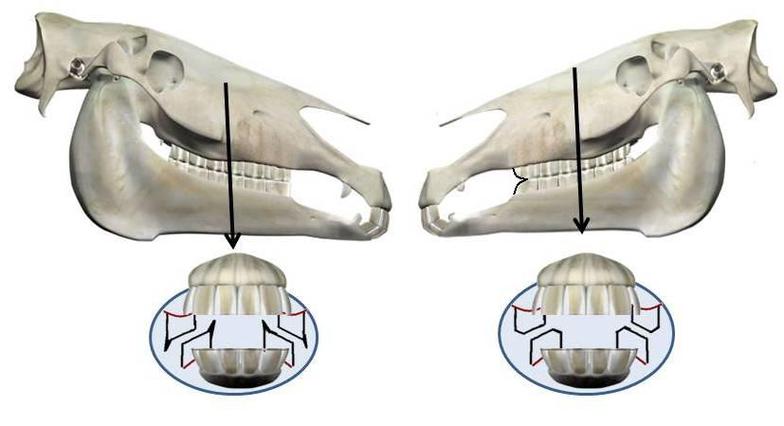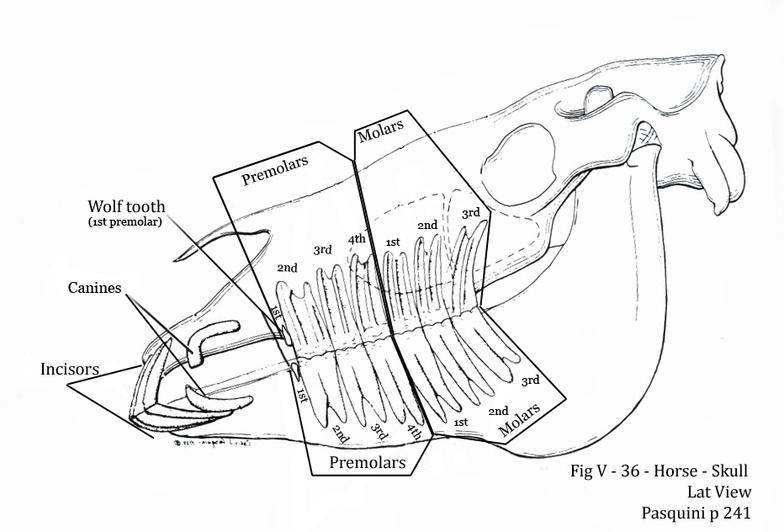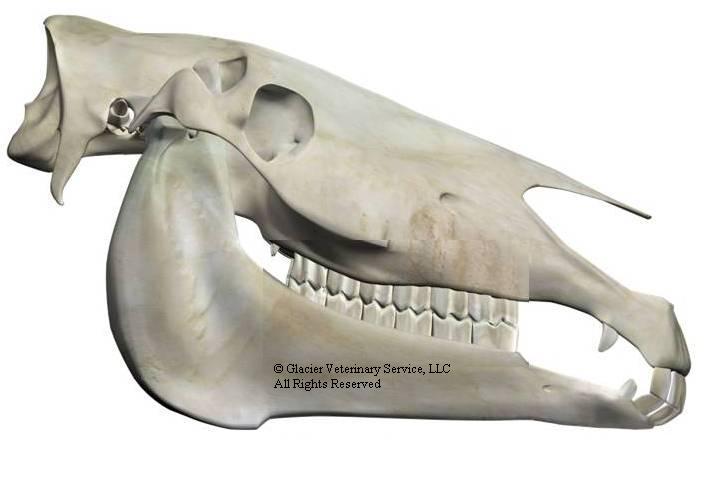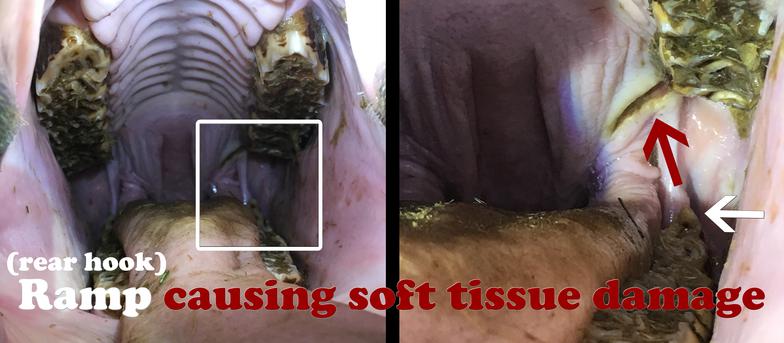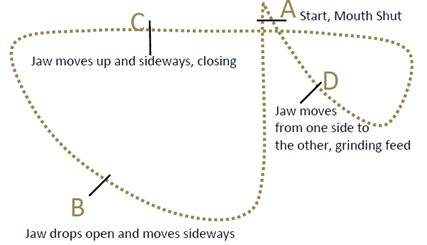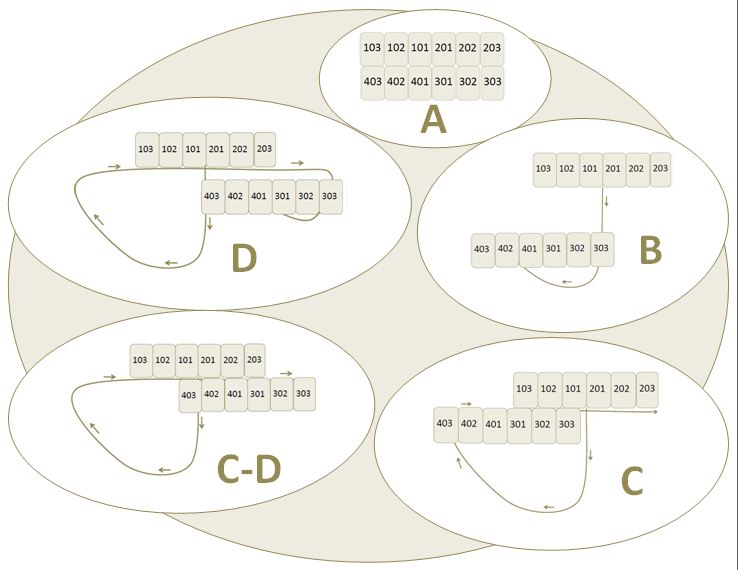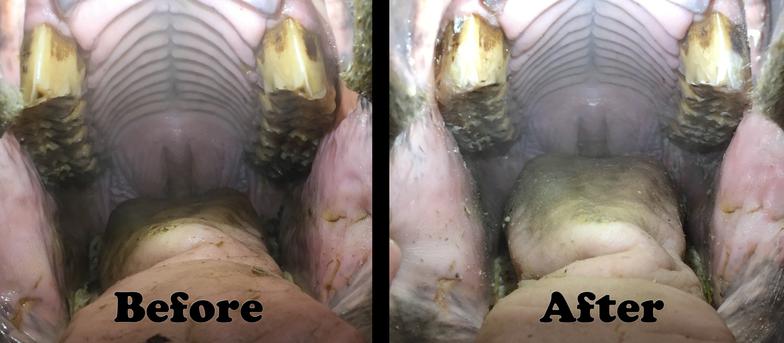Topline Equine Veterinary Care
More About Equine Dentistry
Examples of Common Dental Abnormalities and Conditions
Click image to enlarge
Common Equine Dental Terms
Bit Seat (indicated by black lines on 2nd premolars)
Arcade - Refers to a row of teeth (i.e. there are four arcades of cheek teeth and two arcades of incisors).
Bit seat - Helps to funnel feed into the molars, reduce the bit from bumping on the first molars, and eliminate soft tissue pinch that occurs from gingiva trapping between bit and tooth.
Cap - Horseman’s term for a deciduous (baby, or milk) tooth as it sits in place on the permanent tooth ready to erupt.
Canines - The permanent canines usually erupt between 4 and 6 years of age. Males usually will have four canine teeth, with many females never developing canines. This tooth does not continue to erupt throughout life; so it is common to have long reserve crowns in older horses. It is also common for the canines to accumulate plaque, which mineralizes to calculus and often irritates the surrounding gums. Calculus is usually easily chipped or scraped away.
Cheek teeth - A general term used to indicate all the grinding teeth, the premolars and molars.
Incisors - Front teeth, just inside the lips, used to grasp, nip and pull grass (and to bite you!)
Malocclusion - Abnormal contact between opposing teeth.
Molars - Second three sets of large cheek teeth, top and bottom jaws, used for grinding. There are no deciduous molars; they erupt as permanent teeth.
Occlusion - The contact points of opposing teeth; occlusal surface refers to the chewing or biting surfaces.
Premolars - First three sets of large cheek teeth, top and bottom jaws, used for grinding. There is a full deciduous set followed by a full permanent set.
Wolf teeth - Vestigial teeth which come in many different shapes and sizes. Technically the first premolar, they usually are short crowned with a root two to three times the length of the crown. These small conical teeth can often interfere with the bit and as a result they are often removed. This is due to the position of the teeth, rostral to the second premolars, where a bit would sit. Wolf teeth in young horses (under 3) are usually easier to extract completely than wolf teeth in older horses. As the horse gets older the roots of the tooth can become firmly attached to the bone making them much more difficult to extract cleanly. Blind wolf teeth (unerupted wolf teeth) are usually problematic and are nearly always extracted.
Click image to enlarge
Equine Dentition Diagram
Click image to enlarge
Click image to enlarge
Excessive Transverse Ridges
Click image to enlarge
Excessive Transverse Ridges - molar tables have lateral grooves that inhibit jaw motion
Hooks - sharp protrusions that develop on teeth when an overbite, underbite or other dental deformity causes an imperfect meeting of the top and bottom arcades. Most common on the upper first cheek tooth. Also seen in the lower last molar and sometimes referred to as ramps.
Incisor dental conditions - The most common abnormal incisor wear patterns are ventral curvature (“smile”), dorsal curvature (“frown”) or an offset or diagonal wear pattern (“slant”).
Overbite - (parrot mouth, brachygnathism) is a congenital deformity in which the upper incisors overlap the lower incisors.
Ramps - typically premolars with a surface that slopes like a ski jump. Ramps can cut or scrape the tongue or cheek, especially when a horse is bitted.
Sharp enamel points - develop along the outer (buccal) edge of the maxillary cheek teeth and along the inner (lingual) edge of the mandibular cheek teeth. These points usually develop in the young horse and can be present as early as 2 years of age. If left untreated, they can cause discomfort to the horse, bitting and performance issues, inflammation, irritation and ulceration of the cheek tissue and/or the tongue.
Shear mouth - a dental configuration in which the molars' grinding surfaces are worn at a sharp 60- to 75-degree angle. Normally, the angle is 15 degrees.
Step mouth - is usually the result of an absent tooth. When a cheek tooth is absent, it allows the adjacent teeth in the same arcade to drift out of place. The corresponding tooth on the opposing arcade is allowed to become too long.
Wave mouth - a severely restricting abnormality that occurs when two or more teeth in an arcade are high, creating a series of ascending and declining grinding surfaces.
Underbite - (monkey mouth, sow mouth, prognathism) is a deformity in which the lower incisors extend beyond the upper incisors.
To read more in depth descriptions on these and more equine dental abnormalities, click here.
Click image to enlarge
(1) Extreme overbite, (3) normal bite, (5) extreme underbite
Click image to enlarge
The chewing cycle is a repetition of a cyclical movement of the rhythmical contraction of the muscles that control the opening and closing of the jaw.
There are three parts to the chewing cycle; the dropping or lowering of the mandible and it’s sliding sideways in relation to the maxilla (A-B in diagram to the left), the closing of the mandible against the maxilla (B-C), and the grinding of the mandible across the maxilla(C-D).
The steps are called the opening (A-B), closing (B-C), and power stroke (C-D) phases of chewing.
Some horses will consistently chew or process their food in one direction; others will process or chew their food in both directions. The important point to remember is that mastication (grinding) requires significant motion of the mandible and maxilla in relation to each other. Studies that have examined how the different types of feed affect how a horse chews its food have shown that a much larger range of motion is required to grind hay than a concentrated feed source (i.e. grain).
On average horses lose about 2-3 mm of tooth annually to the grinding forces that occur when they chew. This is referred to as attrition. It has been suggested that some horses are one sided chewers, a condition that could significantly affect attrition patterns.
In the video to the left, the red and black boxes, seen behind the visible incisors, represent a front view of the cheek teeth.
Understanding How Horses Chew
Click images to enlarge
Having trouble getting the picture? Watch this short clip!
Equine Dentistry
Topline Equine Veterinary Clinic generally recommends annual dental examinations.
In some cases, your horse may need a dental exam more frequently.
The term "floating" is often used to describe dental prophylaxis, or the rasping or filing of a horse's teeth, to remove sharp enamel points that can develop over a period of time. These sharp points can cause discomfort to horse, bitting and performance issues, inflammation, irritation and ulceration or mucosal thickening of the cheek tissue and/or the tongue.
Dr. Teigen uses a combination of motorized and manual equipment to keep your horse's teeth in shape.
We treat routine and non-routine cases, offering: power floating, bit seating, extractions (of loose/damaged teeth, canines, caps, and wolf teeth), and radiographs.
An Example of a Routine Dental by Dr. Teigen
Click image to enlarge
Double click here to add text.


